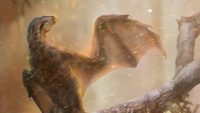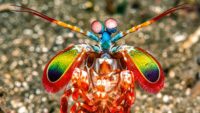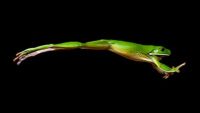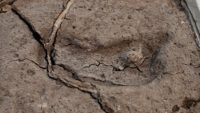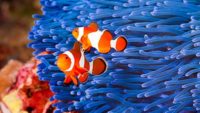The past is the key to the present understanding of these geological features. …read more Source: creation.com
Fleeing the rising waters of Noah’s Flood …read more Source: creation.com
By Ken Ham Headlines around the world are announcing the discovery of a new species of “bat-wing dinosaur” uncovered in China. Researchers are dating this find at 163 million years old. They claim this new species, Ambopteryx longibrachium, had a membranous wing, similar to bats, and that it was a non-avian theropod (read: dinosaur) that represents a dead-end in the evolution of flight. But what was this creature? Be Careful When Reading Popular News Reports! Dr. Gabriela Haynes, a paleontologist who works with our research department, analyzed the scientific paper, published in the journal Nature. Dr. Haynes said when she [More]
By Dr. Elizabeth Mitchell Tiny technology—an environmentally matched biological cloaking device—hides shrimp in plain sight. …read more Source: AIG Daily
Taking the bite out of evolution. …read more Source: creation.com
A recent study on a plant in the mustard family (Brassica Rapa) provides evidence that plants continuously track environmental changes both in real time and across generations. Brassica Rapa utilize regulated innate mechanisms to produce “rapid” and highly tailored responses to the presence of pollinating bees, leaf-eating caterpillars, and the combined activities of both simultaneously.1 … More… …read more Source: icr.org
By Dr. Danny R. Faulkner The latest measure of the Hubble constant (H0) recently made headlines. …read more Source: AIG Daily
By Ken Ham The more we learn about what God has created, the more in awe of our Creator we should be. Just when we think we understand something, a new study shows we really didn’t know as much as we think we did. In fact, as finite beings we know hardly anything about creation compared to what there is to know. The layers of complexity in God’s creation are simply astounding! And that was highlighted in a new study that showed it’s not just our nose that contains olfactory receptors (the protein responsible for detecting smells)—it’s also our tongue. [More]
Does a “primitive” frog show how frog-hopping evolved? …read more Source: AIG Daily
Does lengthening the ‘time frame’ of the Cambrian explosion make it easier for evolutionists to explain? Read More
The word “scallop” usually evokes a juicy, round adductor muscle – a seafood delicacy. So it isn’t widely known that scallops have up to 200 tiny eyes along the edge of the mantle lining their shells. The complexities of these mollusk eyes are still being unveiled. A new study published in Current Biology reveals that scallop eyes have pupils that dilate and contract in response to light, making them far more dynamic than previously believed. “It’s just surprising how much we’re finding out about how complex and how functional these scallop eyes are,” says Todd Oakley, an evolutionary biologist [More]
By Ken Ham Researchers in the South American nation of Chile have announced the discovery of a human footprint they’ve dated at 15,600 years. This makes it the oldest evidence of humans in the Americas by over 3,000 years, according to the evolutionary timeline. How should Christians understand finds such as these? Well, first we compare what the study says against the absolute authority of the Word of God. Starting with God’s Word (using the six days of creation and the genealogies), we know the earth is only around 6,000 years old, and the world was destroyed at the time [More]
By Harry F. Sanders, III A study looked at the colors of lice on the feathers of numerous varieties of pigeons. According to the authors, the research was proof of evolution. Is it so? …read more Source: AIG Daily
How did their digestive biology change to make them need meat? …read more Source: creation.com
Paleontologists just discovered a fossil of a new type of extinct ferocious-looking mammal that’s bigger than any lion or tiger living today.1 This bizarre creature highlights the amazing diversity of lost mammal species that were preserved as fossils in sedimentary rocks deposited during Noah’s Flood. Discoveries like this continue to debunk the evolutionary myth of “simple to complex” that we should find… More… …read more Source: icr.org
By Dr. Carrie John The viceroy is a colorful butterfly that is known to mimic other species. But it is not just a tasty option that looks like the unpalatable models it mimics. …read more Source: AIG Daily
By Harry F. Sanders, III The clownfish is clearly designed for the environment in which it lives while providing some startling challenges to the standard evolutionary model. …read more Source: AIG Daily
The results of a computer analysis to investigate how the solar system might have formed should cause evolutionists to think again about naturalistic processes. …read more Source: creation.com
By Brian Thomas and Jeffrey Tomkins The story of whale evolution is one of the most ridiculous fables of scientifically unsupported speculation ever perpetrated on the public. And now, with the recent discovery of a Peruvian fossil of a clearly four-legged land animal named Peregocetus being called “An Amphibious Whale,” the evolutionary myth has just di… More… …read more Source: icr.org
By Dr. David Menton The secret ingredient to continual breathing? Water. …read more Source: AIG Daily
Have they now finally found a whale missing link, Peregocetus pacificus? …read more Source: creation.com
On April 10, 2019, a team of astronomers revealed the first-ever photograph of a black hole.1 Modern physics sees time and space as being interconnected, forming a kind of “fabric” or “membrane” called spacetime. A black hole is a region of spacetime that is extremely distorted by the presence of a sufficiently dense mass. The gravity in this region is so strong that anything getting too close to … More… …read more Source: icr.org
By Ken Ham The fossil record is full of (mostly marine) creatures that are now extinct. In an attempt to explain all this biodiversity that has since vanished, evolutionary scientists propose a series of mass extinctions caused by various catastrophes, though they frequently disagree on what those catastrophes were. One supposed extinction event, “the Great Dying,” is the subject of new research that claims volcanoes were responsible for wiping out 95% of life on earth. Researchers studied mercury levels in the geologic record from various sites and concluded that this mercury was released by volcanic activity. The massive amounts of [More]
Where do the lowest rocks in the rock record fit in the biblical timeframe? …read more Source: creation.com
How do black holes relate to biblical creation? …read more Source: creation.com
No, it’s evidence for Creation! …read more Source: creation.com
























